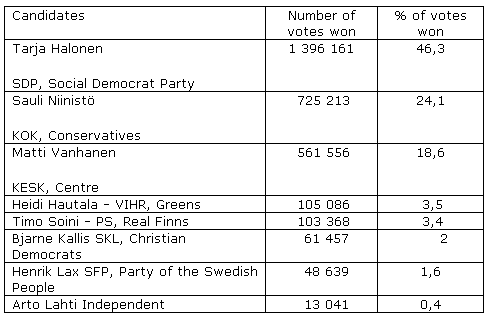News
Corinne Deloy,
Fondation Robert Schuman,
Helen Levy
-

Available versions :
EN

Corinne Deloy
Fondation Robert Schuman
Helen Levy
None of the candidates running won the absolute majority required. A second round will therefore be held on 29th January next. The two leading candidates from the first round will take part: Outgoing president Tarja Halonen who won 46.3% of the vote and Sauli Niinistö who won 24.1%.
The fact that Ms Tarja Halonen did not win the first round was foreseeable for the last few days. After having enjoyed 54% of favourable opinions in the polls for a long period of time, the head of state recorded a progressive decline taking her down to 52% by 10th January. At the very last minute in a very "political" election, partisan differences reappeared to the detriment of the wide consensus that had enveloped the outgoing president for a long time.
The percentage of votes won by Ms Tarja Halonen clearly rose beyond the total of the supporters of the two leftwing parties which had formally approved her: The social democrat party and the left alliance (vas). This number which was gauged at the end of December 2005 lay at around 35 to 36%. Apart from the "premium to the outgoing president" explained by a first mandate that was believed extremely positive by a great number of citizens other factors played in her favour mostly associated with her personal charisma. However the vote in her favour suffered due to an insufficient mobilisation on the part of her potential electorate, in the wake of polls which indicated her inevitable triumph.
The result achieved by Sauli Niinistö, whose conservative party was credited with 21% of the voting intentions at the end of 2005 can be explained by the dynamism of a campaign that facilitated a "wide haul" amongst the "bourgeois" electorate: the other candidates from the centre and the right under-achieved, notably the prime minister who was clearly below the centre party's rating that lay at around 23% at the end of the year.
The situation is now more of an open one – in theory at least – than was forecast just a few weeks ago. The development in participation levels and especially its distribution according to the political preferences of the citizens comprise one of the factors of uncertainty, likewise the attitude of those supporting Ms Hautala.
Above all, who will the votes won by the other candidates now eliminated, in the main those of Matti Vanhanen, now be cast in favour of?
Since the prime minister's party has been linked to the social democrats since 2003 in a tripartite coalition – which includes the swedish party – works relatively well.
But what impact will the declaration by Matti Vanhanen on 15th January assuring Sauli Niinistö – the opposition leader - his support in the second round have?
Mssrs Kallis and lax also adopted the same position.
Sauli Niinistö did not hide a carefully measured amount of satisfaction and indicated that he intended to link up with the centre for his campaign in the second round. The success of this strategy is however not totally clear.
Results of the first round of the presidential election on 15th January 2006
Participation rate: 73.9 %(versus 76.9 % during the first round of the presidential in 2000).
i.e. 3,023,894 votes (including 9 374 blanks and voids)
 source ministry of justice
source ministry of justiceOn the same theme
To go further
Elections in Europe
Corinne Deloy
—
4 November 2025
Elections in Europe
Corinne Deloy
—
28 October 2025
Elections in Europe
Corinne Deloy
—
14 October 2025
Elections in Europe
Corinne Deloy
—
7 October 2025

The Letter
Schuman
European news of the week
Unique in its genre, with its 200,000 subscribers and its editions in 6 languages (French, English, German, Spanish, Polish and Ukrainian), it has brought to you, for 15 years, a summary of European news, more needed now than ever
Versions :



